Pruning basil is simple, results in a bushier and healthier plant, and will also give you larger yields. In this post I’ll tell you why and when to do it, and then show you step by step exactly how to cut back your basil.
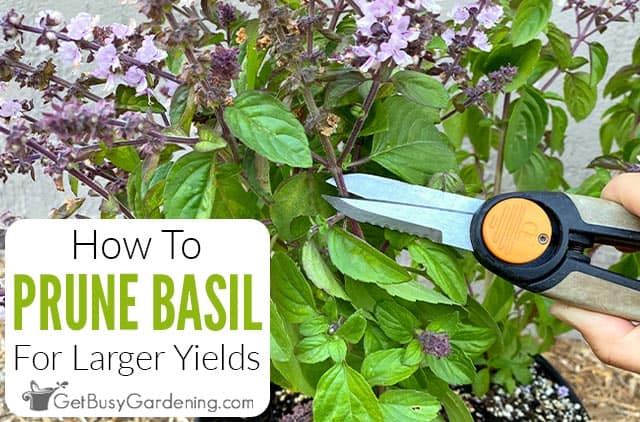
The best way to have the maximum production from your basil is to get into the habit of trimming it back.
Don’t be intimidated. When it comes to pruning plants, basil is easier than you think, and it’s beneficial too.
In this guide, I’ll share two really easy ways to prune basil. I’ll also explain why it’s so important, how to tell when it’s time to give it a little trim, and my favorite tools that make the process a lot easier.
With my tips and step by step instructions, you’ll learn how to do it right the first time, and why regularly cutting basil back will keep them healthier and more productive.
Should You Prune Basil?
For the best results, you should prune basil on a regular basis. That way you’ll maximize the size and length of your harvest.
It’s not absolutely necessary though. You can certainly get a nice amount of leaves from an unpruned plant.
But if yours looks overgrown and is not producing a large amount harvestable leaves, then it’s time to give it a trim.
Why Prune Basil?
If you’re wondering why you should prune your basil, here are four fantastic benefits of doing it on a regular basis…
- Results in larger yields – As long as you keep it cut back, it will continue producing leaves, rather than wasting energy on flowers and seeds. This means a much larger harvest for you.
- Promotes new growth – Pruning also encourages basil to continuously form fresh new leaves. If you allow it to flower, there will be less leaves, and they will also be much smaller.
- Prevents disease – Pinching them back improves airflow, which helps prevent fungus, powdery mildew, and other disease issues.
- Controls shape and size – Unpruned basil can look overgrown, scraggly, sparse, and weedy. Regular trimming results in a bushier, more compact, and a nicer looking plant.
Related Post: How To Grow Basil: The Ultimate Care Guide

When Should Basil Be Pruned?
Now that you know the benefits, let’s take about when you should prune your basil. It’s best to start when they are very young.
You should cut the seedling back by half when it’s 6-8” tall with several sets of true leaves. Then pinch the new tips back every few weeks throughout the entire summer.
If you see flowers beginning to form, remove them immediately to prevent them from maturing and stealing energy from the plant.
But don’t worry, even after they’re in full bloom, you can still trim them to regain control, and encourage the formation of new leaves.
Related Post: How To Grow Basil From Seed
Tools For Trimming Basil
Since the tops are thin and delicate, you might not need to use any tools. Many times, you can simply pinch them out with your fingers. Another option is to use a pair of precision pruners or micro snips.
As they mature, the stems become hard and woody, so you’ll need to use stronger pruning shears to cut those back.
Always use sharp tools so your cuts are precise, and you don’t crush or tear the stem.
It’s also very important to make sure the blades are clean before use to prevent disease. Learn how to clean and sharpen them here.
Techniques For Pruning Basil
There are two basic techniques you can use to prune your basil: cutting back the stems, or pinching off the tips and flower buds. Below I will describe each of these methods in detail.
Cutting Back Mature Stems & Branches
The first technique is to trim the thicker stems and branches. Do this by cutting them back about 1/8″ above a lower set of leaves.
You can remove as much as 1/3 of a stem without worrying about overdoing it. Never remove all of the leaves though, they’re necessary to keep your plant growing and producing.
Related Post: How To Dry Basil (5 Best Ways)
Pinching Basil Flowers & Tips To Promote Growth
Another method is to pinch off the new tips and buds. You can simply pinch out the tender new tips to encourage branching.
You should always remove the flower buds as soon as they begin to form. Otherwise, they will steal energy from the plant as they mature, resulting in smaller and fewer leaves.
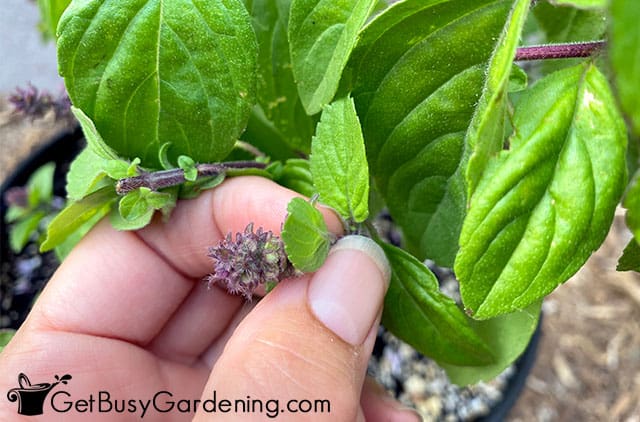
How To Prune Basil Correctly
Now that you know where and when to prune basil, let’s look at how to do it correctly. Below are the detailed step by step instructions.
Step 1: Figure out where to cut – First, trim back the stems just above the smaller lower leaves.
If there are any mature flowers, then trim those stems all the way back to the first set of leaves.
You can remove up to 1/3 of the stem without worry. But, to avoid over pruning, don’t remove all of the leaves, and never cut them down to the ground.
Step 2: Cut right above the next Y branch – Trim the stems about 1/8″ – 1/4″ above the next Y branch. Take care not to break off any of the leaves you plan to keep in the process.
It’s best to make the cut at a downward angle if you can. That way water won’t pool on top of the wound, which could cause it to rot.
If you want, you can keep the clippings and use them to multiply your plants. Learn how to propagate basil cuttings here.
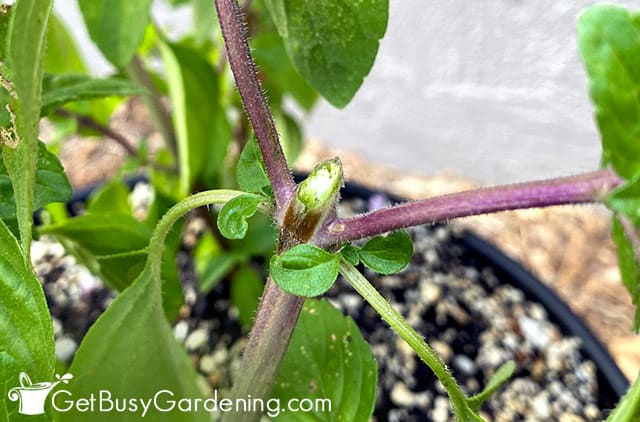
Step 3: Pinch out the flower buds – Check the rest of the plant and look for any new flower buds that are starting to form.
Then simply pinch them out with your fingers, or clip them off with your micro snips or precision shears.
Don’t worry, you don’t have to waste the leaves that you pruned off. If I have enough of them, I like to make homemade pesto. Otherwise, they are easy to preserve and store for later use.
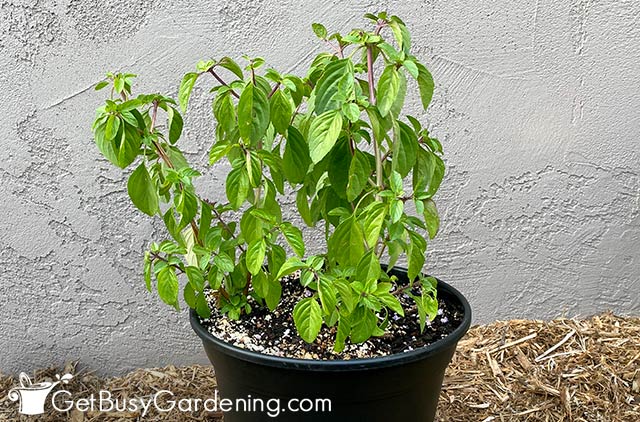
FAQs About Trimming Basil
Below I’ve listed some questions people often ask about cutting back basil that you may find useful too. If you can’t find your answer here, ask it in the comments below.
How do I make my basil bushy?
The best way to make your basil bushy is by pruning it. It’s also important to pinch off the flower buds and new tips as they appear.
Doing this regularly will encourage branching and bushiness, since your plant will funnel all of its energy into producing more leaves.
Does basil grow back after you cut it?
Yes, when done properly, basil will grow back after you cut it. It won’t come back if you take it all the way down to the ground however.
So make sure to only prune it from the top, and never cut back the bottom stems all the way to the ground.
Should I cut the top or bottom of the plant?
You should cut only the top of your basil plant, and never the bottom. Pruning the bottom is not beneficial, will cause it to stop producing, and shorten its lifespan.
When you do it the right way, there are lots of benefits of pruning basil. Always make sure to follow the best practices, and you’ll be rewarded with larger yields, and a healthier, bushier plant.
More About Pruning Plants
- Pruning Rosemary To Promote Growth & Larger Yields
- Pruning Russian Sage: Step-By-Step Instructions
- How To Deadhead Petunias By Pinching & Pruning
Share your tips and advice for pruning basil in the comments section below.
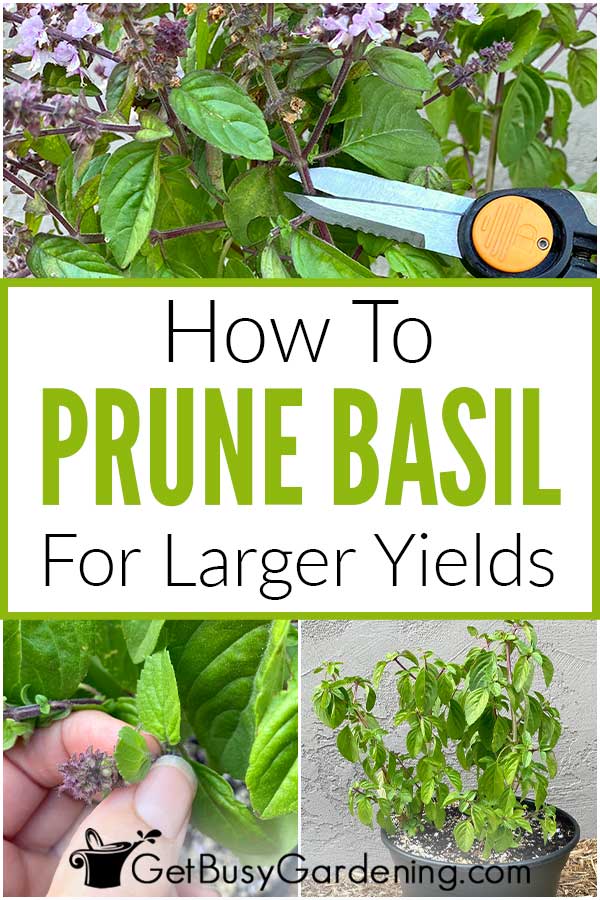
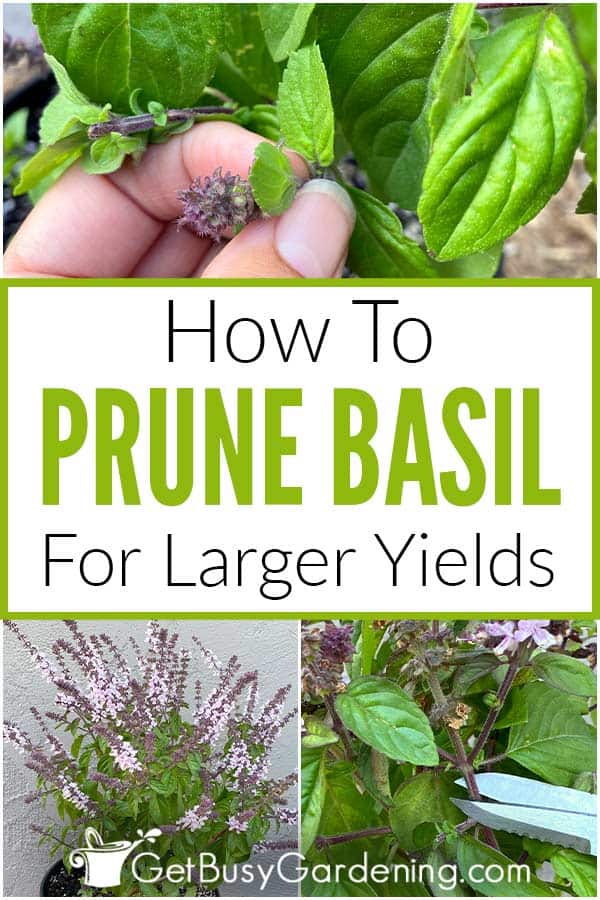
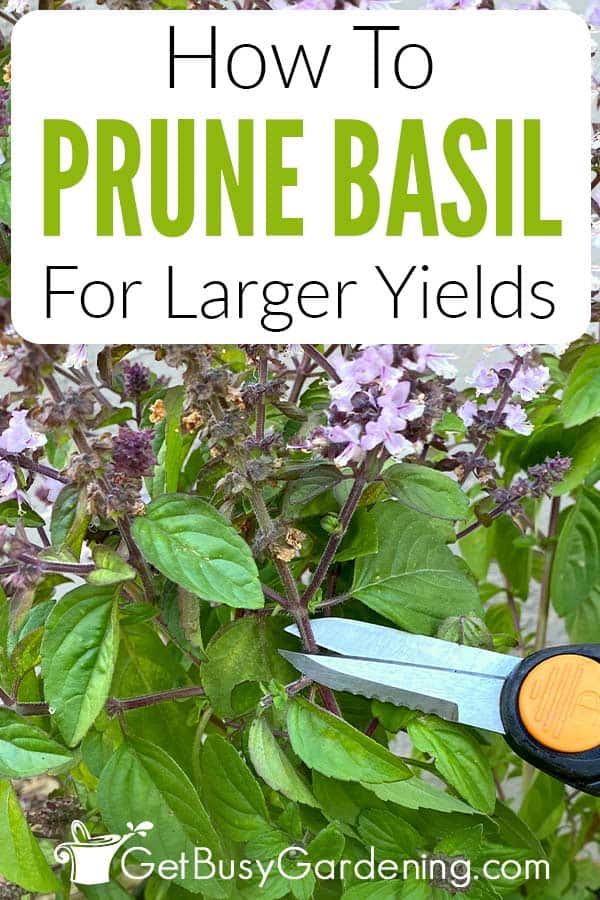

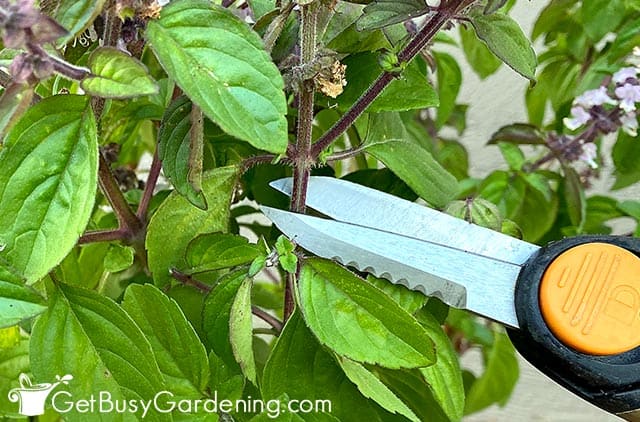
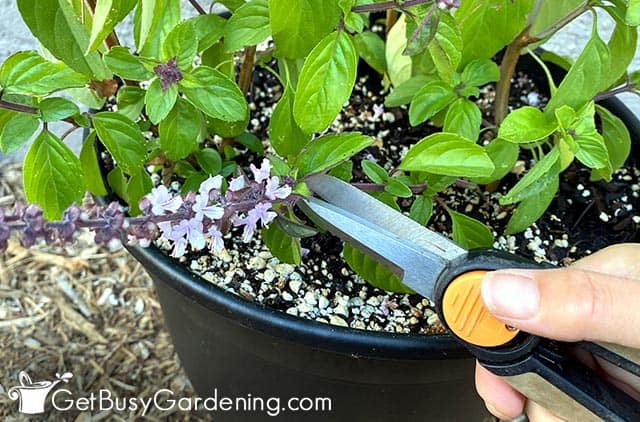

Leave a Reply